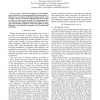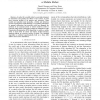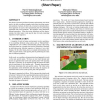1270 search results - page 58 / 254 » Dogged Learning for Robots |
ICRA
2005
IEEE
14 years 2 months ago
2005
IEEE
Abstract Our work aims at developing a robust discriminant controller for robot programming by demonstration. It addresses two core issues of imitation learning, namely what to...
FLAIRS
2001
13 years 10 months ago
2001
: This paper describes a long-terra project to install socially interactive, autonomousmobile robots in public spaces. We have deployed four robots over the last three years, accum...
ICRA
2008
IEEE
14 years 3 months ago
2008
IEEE
— In order for a mobile robot to accurately interpret its sensations and predict the effects of its actions, it must have accurate models of its sensors and actuators. These mode...
ATAL
2008
Springer
13 years 10 months ago
2008
Springer
For robots to become prevalent in human environments, the robots need to be able to perform complex tasks often involving sequential repetition of actions. In this work, we presen...
AAAI
1998
13 years 10 months ago
1998
This paper presents a motivational system for an autonomous robot which is designed to regulate human-robot interaction. The mode of social interaction is that of a caretaker-infa...



